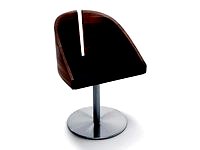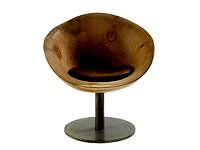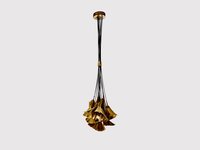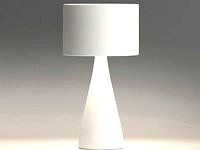IL MOBILE IN LEGNO E L’ACQUA
Se il rapporto legno / Acqua / Ambiente non è IDEALE si possono presentare ritiri o rigonfiamenti del legno a causa della perdita e dell’assunzione di acqua.
Il rapporto tra i 2 principali ritiri ( o rigonfiamenti ) è talvolta indicato con il termine “NERVOSITA’” ed è caratteristico di ogni specie legnosa. L’aria ha la pos-
sibilità di contenere una certa quantità di vapore d’acqua.
Questa quantità dipende anche dalla temperatura ambientale. Più elevata è la temperatura, maggiore è la capacità dell’aria di assorbire vapore acqueo.
L’umidità relativa viene espressa in percentuale (%) ed è il rapporto tra la quantità di vapore presente nell’aria e la quantità massima che questa può con-
tenere a quella temperatura.
Il legno, soprattutto se molto secco, tende ad assorbire umidità dall’ambiente dando luogo al fenomeno di RIGONFIAMENTO.
Se umido, invece, cede umidità all’ambiente e si ha il fenomeno del RITIRO.
All’interno delle nuove costruzioni l’umidità relativa dell’aria può aumentare a causa dell’elevata umidità residua presente ancora nelle strutture ( pareti, pit-
ture, intonaci, ecc.) che per liberarsi, necessita di settimane o addirittura mesi.
Essa è motivo di IMBARCAMENTI, DILATAZIONI e SOLLEVAMENTI delle parti in legno massiccio di cui sono composti i mobili.
Contrariamente LOCALI MOLTO SECCHI determinano la CESSIONE DI UMIDITA’ del legno all’ambiente causando FESSURAZIONI nei componenti di legno
massiccio del mobile che si ritirano.
Una delle cause di instabilità del legno è l’UMIDITA’.
CLIMA AMBIENTALE: L’uomo ha una percezione più immediata della temperatura che dell’umidità. Il controllo di questa ultima, all’interno delle abitazioni,
è spesso trascurato e per questa ragione assai frequentemente vengono a stabilirsi condizioni critiche per il legno.
In INVERNO il funzionamento continuo degli impianti di riscaldamento determina generalmente un clima molto secco che dà luogo nel legno a fenomeni di ritiro.
In ESTATE, viceversa, può stabilirsi un clima più umido, con conseguente tendenza al rigonfiamento.
WOODEN FURNITURE AND WATER
If the ratio wood/water/environment isn’t IDEAL, it is possible to get shrinkage or swelling in the wood because of loss or absorption of water. The ratio be-
tween the two main shrinkage’s (or swellings) is called with the term “NERVOSITA” which is typical for each wood typology.
The air has the possibility to retain a certain amount of water. This quantity depends on the temperature: the higher, the more water vapour it can retain.
The relative humidity is expressed in percentage (%) and it represents the ratio between the water vapour at the time and the maximum it could hold at that
determined temperature.
The wood, especially if very dry, tends to absorb the humidity contained in the air, causing the SWELLING phenomenon. On the contrary, if the wood is very
rich in moisture, in a dry environment, it will release water vapour and consequently, SHRINK.
Within new buildings, the relative humidity could be very high due to the water still present in walls, floor, paints, etc. ant it will take weeks, if not months to
dry; that can cause many problems to furniture such as SWELLING, BENDING or LIFTING of those parts made of solid wood.
On the contrary, a VERY DRY ENVIRONMENT will cause the RELESE OF HUMIDITY from the furniture to the surrounding air, provoking CRACKING in solid
wood components.
One of the cause of wood instability, is HUMIDITY.
AMBIENT CLIMATE: Man has a more ready perception of temperature than humidity. The control of the latter within living areas, is often neglected and for
this reason are often present very critical situation for the wood. In WINTER time, the use of heating, will produce a dry air which will contribute to the wood
shrinkage.
In SUMMER, on the contrary, the air will be much more humid, with consequent tendency to wood swelling.
МЕБЕЛЬ ИЗ МАССИВА И ВЛАЖНОСТЬ
Если влажность окружающей среды не идеальна для дерева, из которого изготовленна мебель, то древесина может поглощать или отдавать
влагу, провоцируя этим усыхание или разбухание. Каждый из видов древесины обладает разной “подвижностью” – т.е. характерной способностью
усыхать или разбухать при изменении влажности и температуры окружающей среды.
Воздух всегда содержит определенное количество воды. Влажность воздуха зависит и от температуры окружающей среды: чем выше температура,
тем больше способность воздуха впитывать водяные пары, то есть тем больше его влажность.
Относительная влажность воздуха выражается в процентах (%) и представляет собой соотношение количества влаги, находящейся в воздухе, с
максимальным количеством, которое она может содержать в себе при данной температуре.
Древесина, особенно если она очень сухая, впитывает влагу из воздуха, провоцируя набухание частей мебели, изготовленных из массива. В
противном случае, дерево отдает влагу окружающей среде, что вызывает его усыхание. Внутри недавно построенных зданий и в помещениях
после ремонта относительная влажность воздуха может быть повышенной из-за высокой остаточной влажности конструкций (стен, стяжек,
покрашенных поверхностей и т.п.), для ее выведения необходимы недели или даже месяцы. Именно повышенная влажность может стать причиной
расширения, вздутия или разбухания частей мебели из цельной древесины.
Наоборот, в очень сухих помещениях происходит отдача влаги деревом в окружающую среду, из-за чего возникают трещины на поверхности
древесины, либо ее сжатие.
Одна из причин не стабильности массива дерева – влажность.
К сожалению, контроль влажности в жилых помещениях зачастую отсутствует. Между тем, он очень важен, так как чрезмерная сухость воздуха,
как и повышенная влажность, одинаково вредны для изделий из натурального дерева.
Зимой, постоянно включенное отопление и обогревательные приборы очень сильно сушат воздух, что вызывает сжатие и усыхание деревянных
поверхностей мебели.
Летом же, наоборот, влажный воздух может привести к набуханию дерева.
4
5







